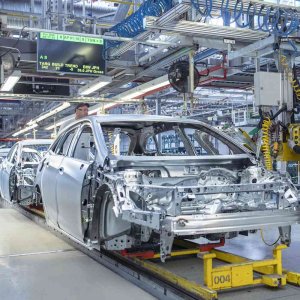Rail Freight Competitiveness Opens Opportunities

STORY INLINE POST
As a largely exports-oriented economic sector, Mexico’s automotive industry needs all the logistics advantages it can muster to ship components and vehicles. Companies tend to prefer road or sea transportation but despite the challenges it faces, the country’s rail infrastructure remains a competitive alternative, especially for long-haul transportation, according to Iker de Luisa, Director General of the Mexican Railroad Association (AMF).
“Automotive is the third-most important sector for railway freight after grains and minerals and cement,” says de Luisa. Refineries, breweries and auto-assembly plants tend to set up shop close to railways because rail-based freight is a highly efficient way to frequently transport large volumes of goods over long distances. OEMs alone have consistently grown their exports year-on-year, surpassing the 3 millionvehicle mark in 2017, which makes rail an attractive solution to take these vehicles to the US. “The longer the distance, heavier the weight and larger the volume, the bigger the advantage rail can provide over road-based transportation,” says de Luisa.
Mexico started developing its rail infrastructure a century ago but involvement from the private sector in rail operations began in the mid-1990s. According to de Luisa, after railways were licensed, Mexico’s rail-based freight increased at an average compound annual growth rate of 4.1 percent through an investment of US$8.5 billion in railroads, trains and locomotives. In comparison, the country’s GDP grew at a 2.9 percent rate. “The fact that rail freight has increased 1.4 times more than Mexico’s GDP illustrates the good health of Mexico’s rail sector,” he says.
Celaya, Guanajuato, is an example of how freight cargo has grown as a consequence of the development of the automotive industry. The city is a key node thanks to railways operated by both KCSM and Ferromex that stem to the north, south, east and west. The city has an exchange yard and handles a significant volume of automotive, grain, steel and petrochemical freight generated locally. The region’s infrastructure keeps expanding; the Celaya rail beltway project, for example, is already 65 percent complete. This project will require a total investment of US$123.1 million, according to AMF, and will improve safety and mobility in the city, while creating a direct access to the Honda plant and increasing efficiency in the region’s exports.
To counter security problems, AMF members are adopting new technologies to minimize and ensure quicker reaction times to incidents. Aside from collaborating closely with federal, state and city authorities, AMF is working alongside CONCAMIN on a legislative proposal that disincentivizes train robberies. “We seek to have the same status as air and sea transportation in terms of security,” says de Luisa.
Successful development of logistics infrastructure requires long-term planning for intermodal transportation, says de Luisa, and that includes rail infrastructure. “Having integral solutions where transportation means are connected with each other benefits the logistics chain and the end consumer,” he says. “Road-based transportation companies in the US no longer see trains as their competition but as an option to complement their service offering and Mexico could follow that example.” There is a significant intermodalservices offering along the Canada-US-Mexico corridor that if combined, could ensure JIT logistics are not broken. “Intermodal transportation offers new opportunities for the longest hauls to be completed by train and last-mile deliveries by truck,” adds de Luisa. “Such a transformation would enable all links of the logistics chain to grow, offer more services and provide users with better solutions.”
For intermodality to work, however, port capacity and the connectivity of Mexican ports and borders with roads and railways are issues that should be looked at. De Luisa also highlights less obvious challenges for Mexico’s logistics, including inspections, customs, working hours at ports and border controls. “Coordination between authorities and the private sector present at the borders or ports is just as important as the construction of new docks or other expansion projects,” he says. “New infrastructure is welcome but paying attention to synergies between government agencies and the private sector and the implementation of adequate public policies are also important.”























